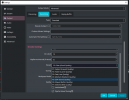megpoid0 submitted a new resource:
High quality recording with multiple audio tracks in Advanced output mode - bottom text
High quality recording with multiple audio tracks in Advanced output mode - bottom text
Advanced output mode allows creating a file with multiple audio tracks - for example, you could livestream your game's audio and your microphone, and also record your system sounds, game audio, and microphone into 3 separate tracks for video editing. (Capturing per-application audio will be added to OBS Studio in the future; currently, the win-capture-audio plugin can be installed for this.)
[COLOR=rgb(247, 218...[/quote]
Read more about this resource...
